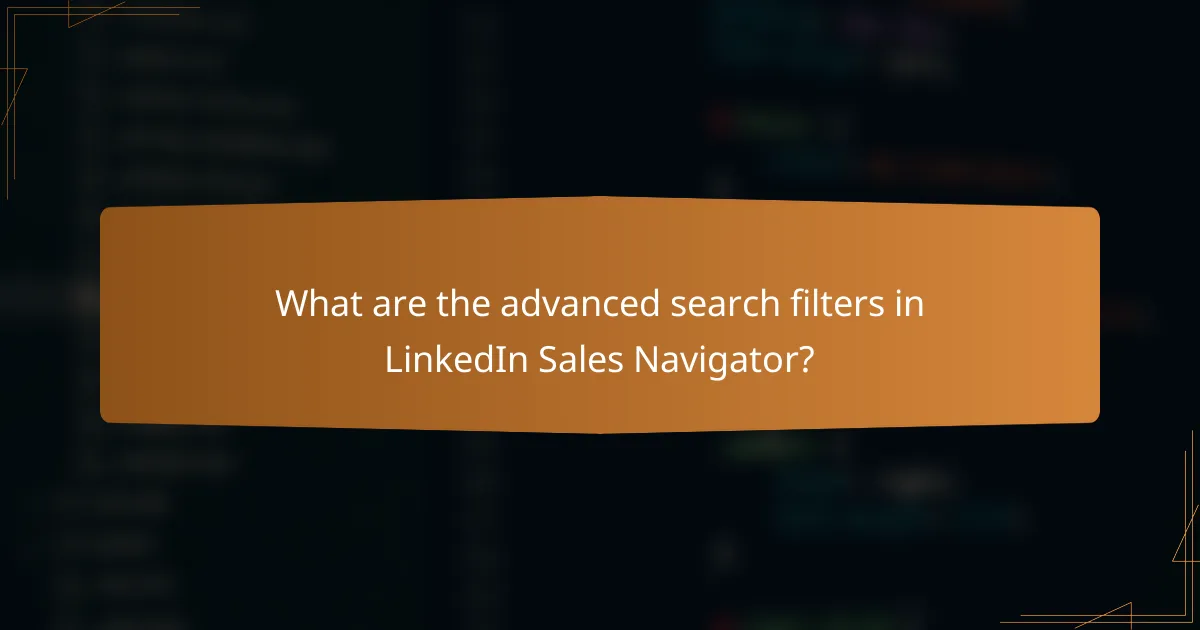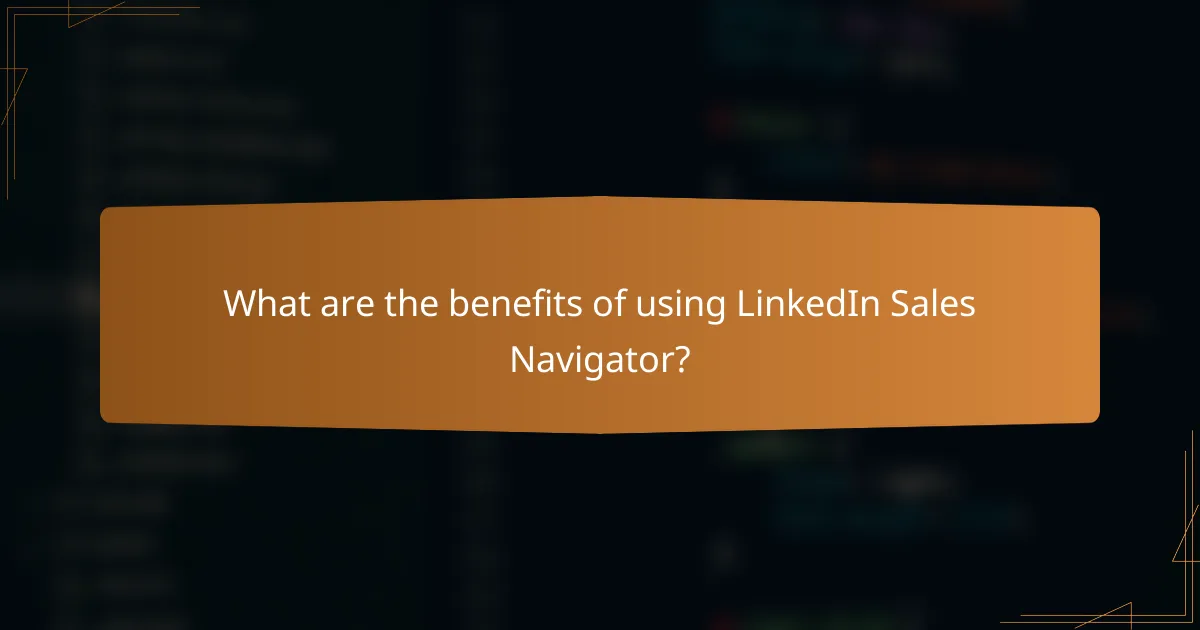LinkedIn Sales Navigator is an essential tool for sales professionals aiming to enhance their lead generation efforts. With its advanced search filters, users can precisely target potential clients based on specific criteria, allowing for more effective outreach and connection strategies. By optimizing searches with these features, sales teams can significantly improve their chances of finding the right prospects to meet their business needs.

How to use LinkedIn Sales Navigator for lead generation?
LinkedIn Sales Navigator is a powerful tool for lead generation that allows users to find and connect with potential clients effectively. By leveraging its advanced features, sales professionals can identify key prospects and tailor their outreach strategies for better results.
Utilize advanced search filters
Advanced search filters in LinkedIn Sales Navigator enable users to narrow down their search based on specific criteria such as industry, company size, location, and job title. This targeted approach helps in identifying leads that are more likely to convert into clients.
For instance, if you are targeting small businesses in the tech sector within the European Union, you can set filters to focus on companies with fewer than 50 employees in relevant countries. This specificity increases the chances of finding high-quality leads.
Identify target audiences
Identifying target audiences is crucial for effective lead generation. Sales Navigator provides insights into potential leads’ behaviors, interests, and connections, allowing users to tailor their outreach efforts accordingly.
Consider creating buyer personas based on your ideal customer profiles. This can include demographics, professional backgrounds, and pain points. By understanding your target audience, you can craft personalized messages that resonate with them.
Engage with potential leads
Engagement is key to converting leads into customers. Use LinkedIn Sales Navigator to send personalized connection requests and follow up with relevant content that addresses the needs of your prospects.
Regularly interact with potential leads by liking or commenting on their posts, sharing valuable insights, or sending them targeted messages. This builds rapport and keeps you top of mind when they are ready to make a purchasing decision.

What are the advanced search filters in LinkedIn Sales Navigator?
Advanced search filters in LinkedIn Sales Navigator allow users to refine their lead generation efforts by targeting specific criteria. These filters enhance the ability to find and connect with potential clients or partners that meet precise business needs.
Geographic location filters
Geographic location filters enable users to specify regions, countries, or even cities when searching for leads. This is crucial for businesses that operate in specific markets or wish to target local clients. For example, you can filter leads to only show those in the European Union or a particular state in the U.S.
When using these filters, consider the market dynamics of the selected locations. Some regions may have higher competition or different regulatory environments, which could affect your outreach strategy.
Industry and company size filters
Industry and company size filters help narrow down leads based on the sector and scale of the organization. You can select from various industries such as technology, healthcare, or finance, and specify company sizes ranging from small startups to large enterprises.
Utilizing these filters allows for more targeted messaging. For instance, if you offer services tailored to small businesses, focusing on companies with fewer than 50 employees can yield better results. Always align your offerings with the specific needs of the industry and company size you target.
Seniority level filters
Seniority level filters allow you to identify leads based on their position within a company, such as entry-level, manager, or executive. This is particularly useful when your product or service is aimed at decision-makers or influencers within an organization.
When applying these filters, think about who has the authority to make purchasing decisions. For instance, if you’re selling enterprise software, targeting C-suite executives or senior managers may be more effective than reaching out to entry-level employees. Tailor your approach based on the seniority level to enhance engagement.

How to optimize searches with LinkedIn Sales Navigator?
Optimizing searches in LinkedIn Sales Navigator involves using advanced filters and techniques to refine your lead generation efforts. By leveraging these tools, you can more effectively target the right prospects based on specific criteria.
Save searches for future use
Saving searches in LinkedIn Sales Navigator allows you to quickly access your most relevant criteria without needing to re-enter them each time. This feature is particularly useful for ongoing campaigns or when you frequently target similar profiles.
To save a search, simply perform your desired search, then click on the “Save Search” option. You can name the search and set up alerts to notify you when new leads match your criteria, ensuring you stay updated on potential opportunities.
Use Boolean search techniques
Boolean search techniques enhance your ability to find specific leads by combining keywords with operators like AND, OR, and NOT. This method allows for more precise searches, enabling you to include or exclude certain terms to narrow down results effectively.
For instance, if you are looking for marketing professionals in the tech industry, you might use a search string like “marketing AND (technology OR software) NOT intern”. This approach helps filter out irrelevant profiles and focuses your efforts on high-quality leads.

What are the benefits of using LinkedIn Sales Navigator?
LinkedIn Sales Navigator offers significant advantages for sales professionals, primarily through its advanced search filters, lead generation capabilities, and targeted outreach strategies. By leveraging these features, users can connect with the right prospects more effectively and efficiently.
Enhanced targeting capabilities
Sales Navigator provides enhanced targeting options that allow users to filter leads based on specific criteria such as industry, company size, geography, and job title. This precision enables sales teams to focus their efforts on the most relevant prospects, increasing the likelihood of successful engagements.
For example, a user can narrow down their search to companies with 50-200 employees in the tech sector located in Europe. This level of specificity helps streamline outreach efforts and improve conversion rates.
Access to real-time insights
With LinkedIn Sales Navigator, users gain access to real-time insights about their leads and accounts, including recent activities, job changes, and shared connections. This information allows sales professionals to tailor their messaging and approach based on the latest developments.
For instance, if a lead recently changed jobs, a personalized message acknowledging this transition can foster a stronger connection. Staying informed about leads’ activities can significantly enhance engagement strategies.
Improved lead engagement
Sales Navigator enhances lead engagement by providing tools to create personalized outreach campaigns. Users can save leads and accounts, receive updates, and utilize InMail messages to reach prospects directly, bypassing traditional email barriers.
To maximize engagement, sales professionals should utilize the platform’s features to craft tailored messages that resonate with the specific needs and interests of their leads. Regular follow-ups based on insights can further strengthen these connections, leading to higher response rates.

How does LinkedIn Sales Navigator compare to other lead generation tools?
LinkedIn Sales Navigator stands out among lead generation tools due to its robust targeting capabilities and integration with LinkedIn’s vast professional network. While other tools offer various features, Sales Navigator excels in providing detailed insights into potential leads and personalized outreach options.
Comparison with HubSpot Sales
HubSpot Sales is known for its comprehensive CRM features and marketing automation, making it suitable for businesses looking for an all-in-one solution. In contrast, LinkedIn Sales Navigator focuses specifically on lead generation and prospecting, utilizing LinkedIn’s database to help users find and connect with potential clients.
While HubSpot offers email tracking and pipeline management, Sales Navigator provides advanced search filters that allow users to narrow down leads based on specific criteria such as industry, company size, and geography. This targeted approach can lead to higher conversion rates for sales teams.
Comparison with ZoomInfo
ZoomInfo is a powerful tool for accessing detailed company and contact information, often used for B2B lead generation. However, LinkedIn Sales Navigator offers unique advantages through its social selling features, allowing users to engage with leads directly on the LinkedIn platform.
Both tools provide valuable insights, but Sales Navigator’s integration with LinkedIn enables users to see mutual connections and engage with leads in a more personal manner. This can enhance relationship-building efforts, which is crucial in sales.

What are the pricing options for LinkedIn Sales Navigator?
LinkedIn Sales Navigator offers several pricing tiers to accommodate different user needs, primarily divided into Professional, Team, and Enterprise plans. Each plan includes varying features, such as advanced search capabilities and lead recommendations, with costs typically ranging from around $80 to $1,000 per month depending on the level of service.
Professional Plan
The Professional plan is designed for individual sales professionals and provides essential tools for lead generation and account management. It typically costs around $80 per month and includes features like advanced search filters, lead recommendations, and the ability to save leads and accounts.
Team Plan
The Team plan caters to small to medium-sized sales teams, offering collaborative features and enhanced reporting. Priced at approximately $100 to $150 per user per month, it includes everything in the Professional plan, plus team management tools and shared insights to improve collective performance.
Enterprise Plan
The Enterprise plan is tailored for larger organizations needing extensive customization and integration options. Pricing for this plan usually starts at around $1,000 per month and varies based on specific requirements. It includes advanced analytics, dedicated account management, and the ability to integrate with CRM systems for streamlined workflows.


